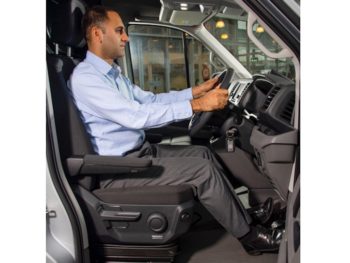Fleets are being urged to ensure van drivers are sitting correctly behind the wheel as new research finds downtime caused by van driver ‘Builder’s Back’ is costing the UK economy £21bn a year.

The study by Volkswagen Commercial Vehicles found more than two-thirds (70%) of van drivers have taken time off work due to back pain, possibly the result of poor seat adjustment. This was backed up by a day’s testing carried out at Cordwallis Van Centre, Heathrow, by VW and a chiropractor from the British Chiropractic Association (BCA) who discovered that while half of van drivers say that they adjust their seat to the correct position, two-thirds are still sitting incorrectly or missing crucial actions.
The testing found that although most drivers adjusted their seats before driving, many committed common mistakes of positioning the seat too close to the steering wheel and angling the seat too far back.
Prab Chandhok, chiropractor and member of the BCA, commented: “Many people now point to driving as a trigger for their back or neck pain, so it’s really important that your van is set up properly for your needs, to help ease the strain that driving – especially for long periods of time – can have on your back and neck.
“The key thing to remember is that there is no single seat that is perfect for everyone, so it’s practical to test the seat out fully before you buy a new vehicle. The more adjustable it is, the better.”
In response, Volkswagen Commercial Vehicles, which offers both ‘ergoComfort’ and ‘ergoActive’ seats, has published some tips for drivers.
Seven Tips to Adjust Your Seat:
Height: Your thighs should be as parallel to the floor as your seat will allow, and where possible try to get your hips higher than your knees. You should also adjust the thigh support if you have one to ensure you have the maximum surface of your thighs touching the seat.
Pedals: You should be able to push the pedals to the floor with a bend in your knees.
110°: Bring your seat all the way up so it’s straight and then take it back until you are comfortable whilst maintaining a 110-degree angle between your back and thighs.
Lumbar Support: The lumbar support should be adjusted so you can feel it support the hollow in your back but so it’s not causing your spine to arch more than is normal for you.
Head Restraint: The height and angle of your head restraint should be adjusted so you can feel the centre of the support touch the middle of the back of your head, although it does not need to be touching at all times
Steering Wheel: Once in correct seating position, bring your arm up in front of you and position the centre of the steering wheel to be in line with the fold of your wrist.
Rear Mirror: Lift up your chest by five degrees and then adjust your mirrors to help stay in an upright position on long drives.

